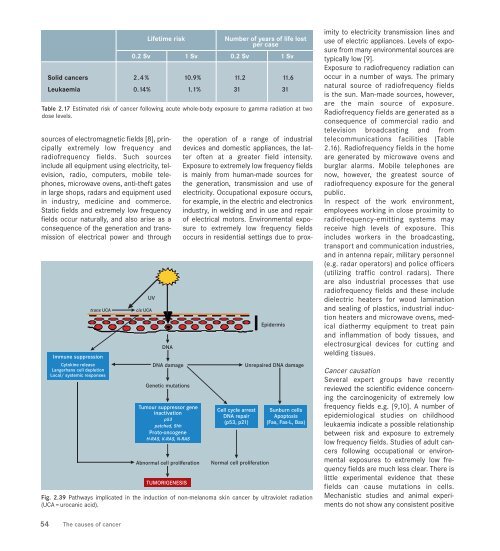world cancer report - iarc
world cancer report - iarc
world cancer report - iarc
Create successful ePaper yourself
Turn your PDF publications into a flip-book with our unique Google optimized e-Paper software.
sources of electromagnetic fields [8], principally<br />
extremely low frequency and<br />
radiofrequency fields. Such sources<br />
include all equipment using electricity, television,<br />
radio, computers, mobile telephones,<br />
microwave ovens, anti-theft gates<br />
in large shops, radars and equipment used<br />
in industry, medicine and commerce.<br />
Static fields and extremely low frequency<br />
fields occur naturally, and also arise as a<br />
consequence of the generation and transmission<br />
of electrical power and through<br />
Immune suppression<br />
Cytokine release<br />
Langerhans cell depletion<br />
Local/ systemic responses<br />
54 The causes of <strong>cancer</strong><br />
UV<br />
trans UCA cis UCA<br />
Lifetime risk Number of years of life lost<br />
per case<br />
0.2 Sv 1 Sv 0.2 Sv 1 Sv<br />
Solid <strong>cancer</strong>s 2.4% 10.9% 11.2 11.6<br />
Leukaemia 0.14% 1.1% 31 31<br />
Table 2.17 Estimated risk of <strong>cancer</strong> following acute whole-body exposure to gamma radiation at two<br />
dose levels.<br />
DNA<br />
DNA damage<br />
Genetic mutations<br />
Tumour suppressor gene<br />
inactivation<br />
p53<br />
patched, Shh<br />
Proto-oncogene<br />
H-RAS, K-RAS, N-RAS<br />
the operation of a range of industrial<br />
devices and domestic appliances, the latter<br />
often at a greater field intensity.<br />
Exposure to extremely low frequency fields<br />
is mainly from human-made sources for<br />
the generation, transmission and use of<br />
electricity. Occupational exposure occurs,<br />
for example, in the electric and electronics<br />
industry, in welding and in use and repair<br />
of electrical motors. Environmental exposure<br />
to extremely low frequency fields<br />
occurs in residential settings due to prox-<br />
Cell cycle arrest<br />
DNA repair<br />
(p53, p21)<br />
Abnormal cell proliferation Normal cell proliferation<br />
TUMORIGENESIS<br />
Epidermis<br />
Unrepaired DNA damage<br />
Sunburn cells<br />
Apoptosis<br />
(Fas, Fas-L, Bax)<br />
Fig. 2.39 Pathways implicated in the induction of non-melanoma skin <strong>cancer</strong> by ultraviolet radiation<br />
(UCA = urocanic acid).<br />
imity to electricity transmission lines and<br />
use of electric appliances. Levels of exposure<br />
from many environmental sources are<br />
typically low [9].<br />
Exposure to radiofrequency radiation can<br />
occur in a number of ways. The primary<br />
natural source of radiofrequency fields<br />
is the sun. Man-made sources, however,<br />
are the main source of exposure.<br />
Radiofrequency fields are generated as a<br />
consequence of commercial radio and<br />
television broadcasting and from<br />
telecommunications facilities (Table<br />
2.16). Radiofrequency fields in the home<br />
are generated by microwave ovens and<br />
burglar alarms. Mobile telephones are<br />
now, however, the greatest source of<br />
radiofrequency exposure for the general<br />
public.<br />
In respect of the work environment,<br />
employees working in close proximity to<br />
radiofrequency-emitting systems may<br />
receive high levels of exposure. This<br />
includes workers in the broadcasting,<br />
transport and communication industries,<br />
and in antenna repair, military personnel<br />
(e.g. radar operators) and police officers<br />
(utilizing traffic control radars). There<br />
are also industrial processes that use<br />
radiofrequency fields and these include<br />
dielectric heaters for wood lamination<br />
and sealing of plastics, industrial induction<br />
heaters and microwave ovens, medical<br />
diathermy equipment to treat pain<br />
and inflammation of body tissues, and<br />
electrosurgical devices for cutting and<br />
welding tissues.<br />
Cancer causation<br />
Several expert groups have recently<br />
reviewed the scientific evidence concerning<br />
the carcinogenicity of extremely low<br />
frequency fields e.g. [9,10]. A number of<br />
epidemiological studies on childhood<br />
leukaemia indicate a possible relationship<br />
between risk and exposure to extremely<br />
low frequency fields. Studies of adult <strong>cancer</strong>s<br />
following occupational or environmental<br />
exposures to extremely low frequency<br />
fields are much less clear. There is<br />
little experimental evidence that these<br />
fields can cause mutations in cells.<br />
Mechanistic studies and animal experiments<br />
do not show any consistent positive

















